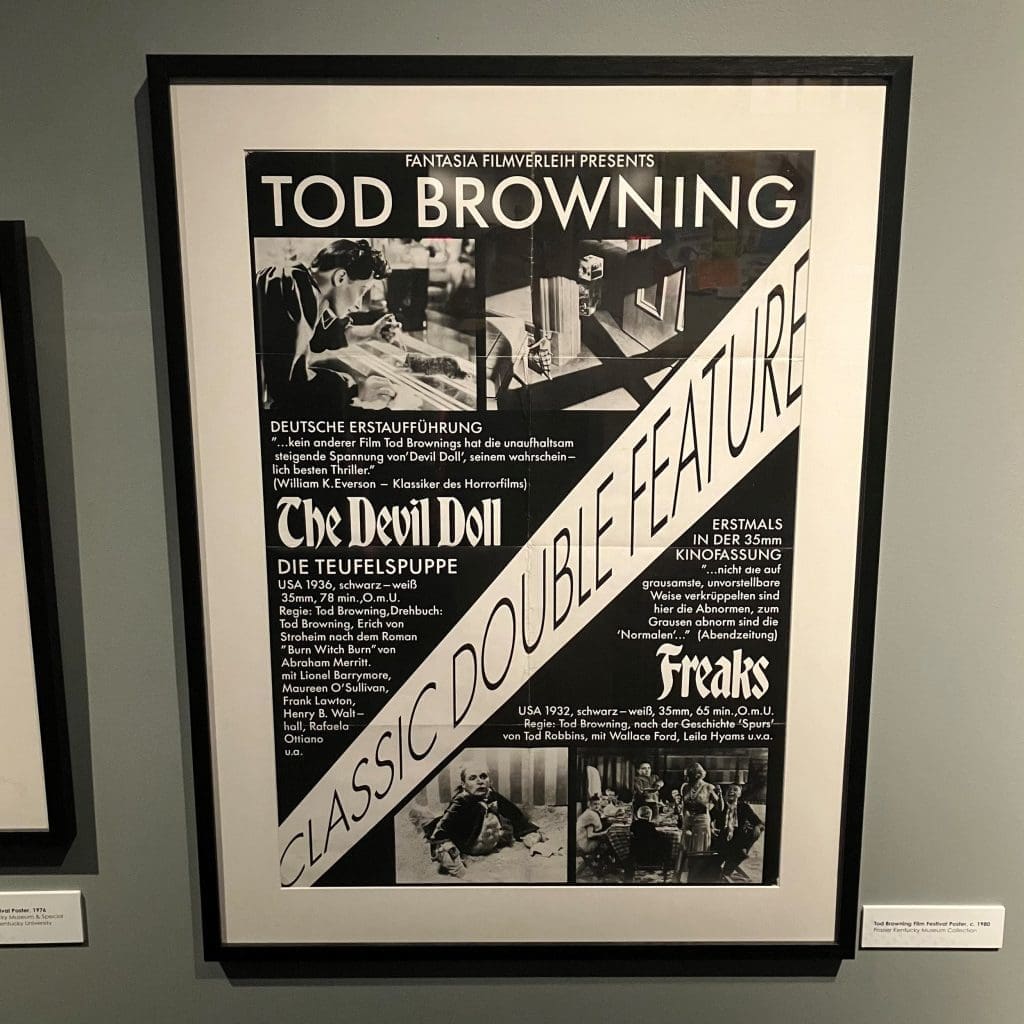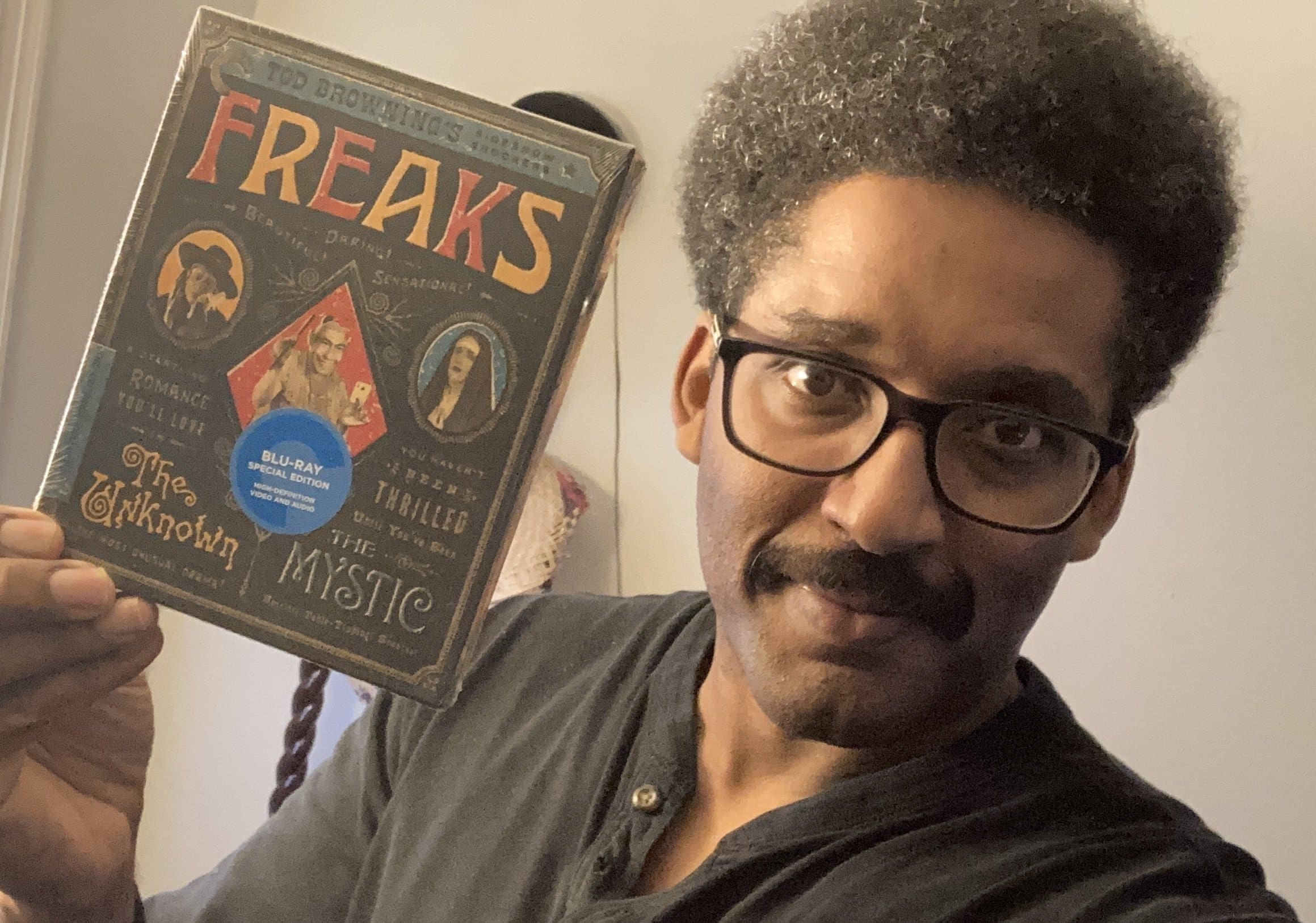My memory of Freaks goes all the way back to my childhood in the 1980s. On Friday nights, when my mother allowed me to stay up past bedtime, I would watch horror movies on WHAS-11 TV. Freaks was one of those films that appeared on the channel, to the best of my recollection.

Mylar ad for Freaks, 1932. Credit: United Artists.
Based loosely on Tod Robbins’s short story “Spurs,” Freaks is a revenge story told through the eyes of several members of a traveling carnival troupe, who take vengeance upon an adulterous trapeze artist (Olga Baclanova), who is found trying to poison her cuckolded husband, a little person (Henry Earles), on their wedding night. “Gobba-Gobble! One of us! One of us!,” the carnival troupe chants during the famous wedding feast scene. In the rain-drenched climax, the troupe slowly encircle the trapeze artist and dispatch her to a fate worse than death.
The movie’s grim, grisly shock ending stayed with me into adulthood — so much so that I bought the Warner Archive DVD in the early 2000s and received the brand-new Blu-ray release of the film from the Criterion Collection this month.


German-language poster for a Tod Browning Film Festival featuring Freaks (1932) and The Devil Doll (1936) on display in the Frazier’s Cool Kentucky exhibition, October 20, 2023. Credit: Frazier History Museum.
Released in 1932, Freaks is a landmark film in the history of Hollywood and that of its director Tod Browning (1880–1962) — a Louisville native who is celebrated in the Frazier Museum’s Cool Kentucky exhibition. Freaks is considered by many as one of the final nails in the coffin for Pre-Code Hollywood, an era in when crime did pay at the movies, drugs were not considered a vice, and showing a little leg was not a sin. Freaks also signaled the end of Browning’s time as a major player in Hollywood.
Before Freaks, Browning was flush with success. His prior film, Dracula (1931), had been an unqualified box office smash, had made Hungarian stage actor Bela Lugosi a movie star, and had created a monster franchise for its producer, Universal Pictures Corporation, in the process.
Because of Dracula, rival studio Metro Goldwyn-Mayer (MGM) gave its prodigal son Browning near-total artistic control to create his next horror hit. Unfortunately for Browning and MGM, critics and the moviegoing public were not thrilled at all about what he had in mind for an encore. In fact, they were offended and downright frightened by it.


Lobby card for Freaks, 1932. Credit: Employees of MGM.
Audiences were revolted by Browning’s choice (leaning on his own experience as a carny huckster himself) to cast actual sideshow performers, like conjoined “Siamese Twins” Daisy and Violet Hilton, the armless and legless Prince Randian, and Schlitzie, as members of the carnival troupe in Freaks. The film board in Atlanta, Georgia, barred the film from being exhibited there. Great Britain banned the film entirely from being shown anywhere on the Isle. The ban there remained in place for thirty years.
One member of the standing committee on motion pictures for the National Association of Women sent a copy of her unpublished film review of Freaks to Will H. Hays (creator of the Hays Code), asking how MGM could “stoop to the disgrace of making money out of hurt, disfigured, and suffering humanity.” But Freaks made no money for MGM upon initial release. It took them to the cleaners. According to Browning biographers David Skal and Elias Savada, it cost MGM $316,000 ($6.8 million in today’s dollars) to make Freaks in 1931 and the studio lost $164,000 ($3.6 million) in 1932 during the film’s original run.
After Freaks, Tod Browning continued to find work directing and writing treatments for movies. But he never again reached the heights of success and autonomy he had attained with Dracula. He quietly left the spotlight of Hollywood for good in 1942, living a retired life with his wife Alice Browning and their two St. Bernards in Malibu, California, until his death on October 6, 1962.
However, Freaks would not die. In the 1960s, the film was reassessed by film critics and became a cult classic among film enthusiasts and horror fans. It now is part of a Blu-ray set from the Criterion Collection.
Titled Tod Browning’s Sideshow Shockers, the two-disc set includes an essay by noted film critic Farran Nehme, an audio recording of “Spurs” (read by Browning biographer David Skal), and restored versions of Freaks and two silent films by Browning. They are The Unknown (1927), starring Lon Chaney and Joan Crawford, and The Mystic (1925), starring Aileen Pringle and Conway Tearle.
For more interesting Kentucky history content, subscribe to the Frazier Museum’s free newsletter “Frazier Weekly.”



